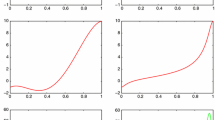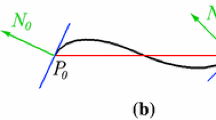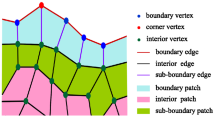Abstract
This paper presents a new, volumetric subdivision scheme for interpolation of arbitrary hexahedral meshes. To date, nearly every existing volumetric subdivision scheme is approximating, i.e., with each application of the subdivision algorithm, the geometry shrinks away from its control mesh. Often, an approximating algorithm is undesirable and inappropriate, producing unsatisfactory results for certain applications in solid modeling and engineering design (e.g., finite element meshing). We address this lack of smooth, interpolatory subdivision algorithms by devising a new scheme founded upon the concept of tri-cubic Lagrange interpolating polynomials. We show that our algorithm is a natural generalization of the butterfly subdivision surface scheme to a tri-variate, volumetric setting.
Similar content being viewed by others
References
Bajaj C, Shaefer S, Warren J, Xu G (2002) A subdivision scheme for hexahedral meshes. Vis Comput 18(5–6):343–356
Bertram M (2002) Biorthogonal wavelets for subdivision volumes. Proceedings of the Seventh ACM Symposium on Solid Modeling and Applications, pp 72–82
Catmull E, Clark J (1978) Recursively generated B-spline surfaces on arbitrary topological meshes. Comput Aided Des 10:350–355
Chang Y, McDonnell KT, Qin H (2002) A new solid subdivision scheme based on Box splines. Proceedings of Seventh ACM Symposium on Solid Modeling and Applications (Solid Modeling 2002), Saarbruecken, Germany, pp 226–233
Chang Y, McDonnell KT, Qin H (2003) An interpolatory subdivision for volumetric models over simplicial complexes. Proceedings of the International Conference on Shape Modeling and Applications (SMI 2003), Seoul, Korea, pp 143–152
Doo D (1978) A subdivision algorithm for smoothing down irregularly shaped polyhedrons. Proceedings on Interactive Techniques in Computer Aided Design, pp 157–165
Dyn N, Hed S, Levin D (1993) Subdivision schemes for surface interpolation. Proceedings of the 1992 Workshop on Computational Geometry. World Scientific, River Edge, NJ, pp 97–118
Dyn N, Levin D, Gregory J (1987) A four-point interpolatory subdivision scheme for curve design. Comput Aided Geom Des 4(4):257–268
Dyn N, Levin D, Gregory J (1990) A butterfly subdivision scheme for surface interpolation with tension control. ACM Trans Graph 9(2):160–169
Dyn N, Micchelli CA (1990) Using parameters to increase smoothness of curves and, surfaces generated by subdivision. Comput Aided Geom Des 7:129–140
Linsen L, Pascucci V, Duchaineau MA, Hamann B, Joy KI (2002) Hierarchical representation of time-varying volume data with \(\sqrt[4]{2}\)subdivision and quadrilinear B-spline wavelets. Proceedings of Tenth Pacific Conference on Computer Graphics and Applications, pp 346–355
MacCracken R, Joy KI (1996) Free-form deformations with lattices of arbitrary topology. Computer Graphics Proceedings, Annual Conference Series, ACM SIGGRAPH, pp 181–188
McDonnell KT, Qin H (2001) FEM-based subdivision solids for dynamic and haptic interaction. Proceedings of Sixth ACM Symposium on Solid Modeling and Applications (Solid Modeling 2001), Ann Arbor, Michigan, pp 312–313
McDonnell KT, Qin H, Wlodarczyk RA (2001) Virtual clay: A real-time sculpting system with haptic toolkits. Proceedings of 2001 ACM Symposium on Interactive 3D Graphics, Research Triangle Park, North Carolina, pp 179–190
Muuss MJ, Butler LA (1991) Combinatorial solid geometry, boundary representations, and n-manifold geometry. In: Rogers DF, Earnshaw RA (eds) State of the art in computer graphics: visualization and modeling. Springer, Berlin Heidelberg New York, pp 185–223
Pascucci V, Bajaj C (2000) Time critical isosurface refinement and smoothing. Proceedings of the 2000 IEEE Symposium on Volume Visualization, pp 33–42
Reif U (1995) A unified approach to subdivision algorithms near extraordinary vertices. Comput Aided Geom Des 12:153–174
Warren J, Weimer H (2001) Subdivision methods for geometric design: a constructive approach. Kaufmann, San Francisco
Weiler KJ (1986) Topological structures for geometric modeling. Dissertation, Rensselaer Polytechnic Institute
Zorin D (2000) Smoothness of stationary subdivision on irregular meshes. Constr Approx 16:359–398
Author information
Authors and Affiliations
Corresponding author
Rights and permissions
About this article
Cite this article
McDonnell, K., Chang, YS. & Qin, H. Interpolatory, solid subdivision of unstructured hexahedral meshes. Vis Comput 20, 418–436 (2004). https://doi.org/10.1007/s00371-004-0246-2
Published:
Issue Date:
DOI: https://doi.org/10.1007/s00371-004-0246-2




